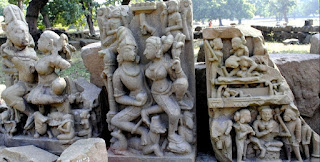 (Ramgarh>Surguja>Chhattisgarh>India)
(Ramgarh>Surguja>Chhattisgarh>India)
History and geography:The
presence of various temples stone carvings and archaic remains show the
evidence of existence of this region before Christ(B.C.).
In
4Th B.C. Before the arrival of maurya dynasty,this region was
in the Lord of Nanda clan. Before 3 B.C. this region
was divided into tiny parts and their headman after quarrel among themselves. Then a Rajputa kings belongs
to Rakshal clan in palamu district (Bihar) attacked and taken in his
control. In 1820 Amar singh was the Kings of Surguja state who had been
crowned as “Maharaja” in 1826. In 1882 Raghunath Sharan Singh Deo had
taken his control over Surguja state
who has been conferred as “Maharaja” by Lord Daffariu. After the
contemporary victory of India he established Edward Middle School, Post
Office ,Telegraph Office ,Medical stores ,jail and courts in Ambikapur
capital of Surguja.
Ambikapur is a small town and a place connected with the Indian epics Ramayana and Mahabharata, situated near the Vindhyachal - Baghelkhand Mountain ranges. Ambikapur is in Surguja district in the state of Chhattisgarh.
Surguja is surrounded by various states viz., Jharkhand, Uttar Pradesh, Orissa and Madhya Pradesh.
Ambikapur is situated at an altitude of 603 meters. Surguja has a
spread of over 22,237 sq. km. Most of the terrain of the district is
hilly and forested.
A majority of the inhabitants in this place belong to the Pando and Korwa tribes, who regard themselves as descendants of the Pandavas and Kauravas,
( still living in forest, the Pando tribes believes themselves as the
member of "Pandav" clan of epic Mahabharat. Korwa tribes believes to be member
of "Kauravs" of Mahabharata). Agriculture is the major occupation. Paddy is the main grain grown
which contributes to the major part of their income. The natural
resources available here include coal and bauxite.
The rivers flowing across Surguja district are Kanhar, Rihand, Moran and Mahan. Temple carvings and archaic ruins date the history of this place to the era before Christ (BC). According to the holy books Lord Rama had visited Surguja during his fourteen years of exile and a number of places here are named after him, his brother Laxman and wife Sita, places like Ramgarh, Sita - Bhengra cave and Laxmangarh. Verses of Poet Kalidas who wrote "Ramayan" are found at the Sita-Bhengra cave.
The rivers flowing across Surguja district are Kanhar, Rihand, Moran and Mahan. Temple carvings and archaic ruins date the history of this place to the era before Christ (BC). According to the holy books Lord Rama had visited Surguja during his fourteen years of exile and a number of places here are named after him, his brother Laxman and wife Sita, places like Ramgarh, Sita - Bhengra cave and Laxmangarh. Verses of Poet Kalidas who wrote "Ramayan" are found at the Sita-Bhengra cave.
The great Sanskrit poet, Kalidasa,
wrote the epic “Meghdoot”. In this poem, he imagines the passing clouds
as his messengers and uses them to convey his love to his wife. In the
poem, he explains to the clouds the direction and narrates the beauty of
Ramgiri mountain It is clear that he had spent some time in this place.
This Ramgiri mountain is one of the exotic locations to be visited near
Ambikapur.
Rock art/cave paintings(शैलचित्र) of Ramgarh:The paintings and inscriptions found in the rocky caves of this hill, surrounded by dense forest is of immense importance as throwing light on the history of the period inhabited, the people and their beliefs, deep down in the history of mankind.





































